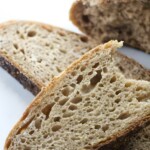100% Spelt Sourdough Bread
Whole wheat spelt makes delicious, rustic sourdough bread. This recipe is easy to make with basic instructions that are easy for beginner sourdough bakers.
Servings: 1 loaf
Ingredients
- 1 cup active sourdough starter (240 grams)
- 1 ¾ cups warm water (413 grams)
- 4 ¼ to 5 ¼ cups whole wheat spelt flour (550 to 680 grams)
- 2 teaspoons salt (12 grams)
Instructions
- Combine all the ingredients in the bowl and stir until it is well combined. The dough will have a rough, chunky look.
- Dump the dough onto a work surface and knead the dough with your hands until it is smooth. Approximately 10 to 12 minutes. (Essentially, you are massaging the dough by stretching and pushing. This will help develop the gluten.) At this stage, it will be wet and sticky. Try not to add more flour or your finished bread will be dense and heavy. The dough will stick to your hands and feel messy but if you get your hands wet it won't stick as easily.
- Place the dough into an oiled bowl and turn it so oil coats the top of the dough. Cover with plastic wrap and let it sit at room temperature for 3 to 6 hours (see notes) or in the refrigerator overnight. (A longer proof time in the fridge will give the bread a more complex, sourdough flavor.)
- Turn the dough out onto a work surface and form it into a round ball. (See notes)
- Place the ball of dough into a proofing basket or any container that is the shape that you want your bread to be shaped. (See notes)
- Let the dough rise again a second time for 3 to 6 hours** at room temperature until almost doubled in size. (Or you could let it rise in the fridge overnight for 12 to 15 hours)
- Preheat the oven to 450°F. Place the Dutch oven inside so it gets hot. It should take 20 to 30 minutes to preheat the Dutch oven.
- Place a piece of parchment on a board then lay it on top of the proofing basket. Flip the board and basket so the basket is on top then remove the basket.
- When the oven is hot, use the parchment paper to place the bread into the Dutch oven. Make a slash in the loaf with a sharp knife. For an extra burst of steam and a slightly higher rise, spray the dough with a bit of water.
- Bake for 20 minutes then remove the lid and finish baking for another to 30 to 35 minutes.
- Let the bread cool completely before slicing it.
Video
Notes
Use an active, peak starter: Your starter should be at its peak activity level for the best rise and flavor. If it’s sluggish, your dough will be too.
Adjust rise time to your environment: Rising times will vary based on temperature and humidity. A warmer space (like a proofing box or dehydrator) will speed things up; a cooler room or the fridge will slow it down and deepen the flavor through longer fermentation.
Don’t let it double: Spelt has a weaker gluten structure than traditional wheat, so aim for a rise of 1½ the original size. Letting it double, or go beyond, can cause it to collapse when baked.
Weigh your ingredients: Spelt flour is finicky, and using a scale gives you the consistency cups can’t.
Skip the extra flour: When kneading or shaping, avoid dusting the counter. Too much flour makes for a dense loaf. Instead, keep your hands damp to prevent sticking.
Prep your proofing basket properly: Whether you're using a Brotform or a towel-lined bowl, dust it generously with a 50/50 mix of rice flour and all-purpose flour. Rice flour helps prevent sticking, unlike regular flour which absorbs moisture and clings to the dough.
No Dutch oven? : You can bake this bread on a baking sheet or pizza stone. A Dutch oven helps trap steam for a crustier crust, but it’s not required.
Nutrition
Serving: 1slice | Calories: 173kcal | Carbohydrates: 36g | Protein: 8g | Fat: 1g | Polyunsaturated Fat: 1g | Sodium: 216mg | Fiber: 6g | Sugar: 1g
